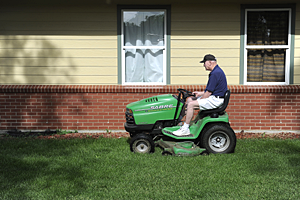
What’s America’s favourite hobby? Day-trading? Competitive eating? Playing baseball?
Nope. It’s actually gardening.
Survey after survey demonstrates that the average American likes nothing more than getting into their backyard and digging it up.
Even although much of the US has a desert or tropical climate, billions are spent keeping lawns a luscious shade of green. The US environment agency, the EPA, reckons that a third of US water consumption by households goes on gardening.
Like most housing-related sectors, the gardening business was hit hard during the recession. But with the property market booming again, people are splashing out on their gardens once more.
Here’s how you can profit…
Not even lawn-mowing is invulnerable to recession
When the financial crisis kicked off, many captains of industry swore blind that their particular sector would be totally unaffected. The lawn and garden industry was one of them.
To be fair, there are good reasons to expect lawn maintenance to continue during a slump. A lawn is one of the most noticeable parts of a property. If you want to sell your house, you have to keep it looking good. And in many cases, local bylaws meant steep fines for anyone who didn’t take care of the appearance of their home.
And in fact, households continued to spend in 2007 and 2008. But as the slump deepened, sales started to slide. A manicured lawn starts to lose its importance when you’re getting worried about the mortgage payments and hanging on to your job.
More importantly, the wave of foreclosures (what we’d call repossessions in the UK) only peaked in 2011, leaving hundreds of thousands of properties empty and in the possession of banks – who were not that worried about the state of the lawns they now owned.
Even last year, households were still too wary about the future to start spending big again. But now, with house prices clearly moving higher – and some areas even looking distinctly bubbly – owners have a big incentive to reinvest in their gardens.
As a result, sales for gardening-related businesses are picking up. While they remain below pre-crisis levels, market research firm Mintel estimates that by 2016 the lawn and garden products market could be worth $45bn. This is 20% higher than the in 2011.
The quest for a ‘supergrass’
Let’s get back to that water issue that I mentioned earlier. In recent decades, the population of ‘sunbelt’ states (such as Arizona and Florida) has boomed.
That growing population has put added pressure on already-stretched water supplies in these arid areas. This problem has only been made worse by a number of hot, dry summers.
That means there’s pressure on households to cut consumption. And as we all know from hosepipe bans in our own country, the garden is one of the first casualties when water supplies run low.
One approach is to pass laws forcing households to pay more attention to water waste. Popular measures include restricting the time that sprinklers can run, especially during the summer and the middle of the day. Some areas are going further by placing limits on the size of lawns.
However, a less draconian approach is to use technology to create breeds of grass that simply need less water. Of course, there are already types of grass that are far less thirsty than others. But these tend to be less pleasing on the eye than the clipped green lawns we know and love from golf courses and TV adverts.
There’s a huge market here. Any firm that could develop a ‘supergrass’ that economises on water, but remains soft and attractive to look at, stands to make a lot of money – as well as solving a serious problem.
One stock to buy now
That’s why Scotts Miracle-Gro Company (NYSE: SMG) looks particularly well-placed to profit from the recovery in the gardening business.
The company specialises in a wide range of lawn and garden-related products. It also runs a lawn maintenance service. While sales have taken a hit in the last few years, they have started to bounce back. By 2016, revenues are expected to have rebounded by nearly 33% from the 2011 trough.
The company is also working hard on a low-maintenance breed of grass. It already makes a breed that is resistant to Roundup, a popular weedkiller. It is also trying to boost margins by slashing costs and waste within the organisation.
Better yet, the prices of nitrogen and urea, its two main inputs, are falling, says Jp Morgan. Overall, the bank believes that earnings will surge by 57% over the next three years. Trading on 13 times 2016 earnings, and offering a dividend yield of 3.3%, it looks like a very attractive play on America’s most popular hobby.
• This article is taken from our free daily investment email, Money Morning. Sign up to Money Morning here.
Our recommended articles for today
Big data and the vast potential for returns
Our lives have already been transformed by the rise of ‘big data’. David Thornton explains how, and tips one share to keep a close eye on.
Why you need to invest overseas
There’s a lot of negativity surrounding emerging markets at the moment. Bengt Saelensminde explains why that spells opportunity, and how you could profit.